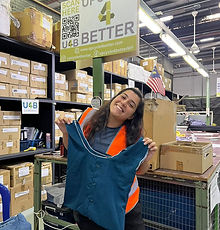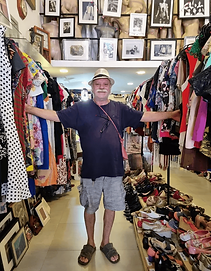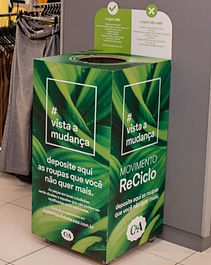Brazil
- Written by Carolina
Which kind of waste bins do you have in your household?
For solid waste, the bins are plastic (red), paper (blue), organic waste (brown), metal (yellow), glass (green). Although some cities have textile drop-off bins set up by local governments, there is no national system to manage textile waste. There are a lot of private companies' initiatives, though.

What would you say is the general attitude toward secondhand clothing in Brazil?
The general attitude toward secondhand clothing has been shifting in recent years. Secondhand fashion is increasingly seen as trendy, sustainable, and affordable. Many young people actively buy and sell used clothes through online platforms and local thrift shops.
However, there is still some stigma, some people may associate secondhand clothing with financial hardship or a lack of hygiene. This perception can make it socially uncomfortable for some to openly embrace used clothes.
Where do people usually buy or sell secondhand clothes?
In Brazil, secondhand clothing is very accessible. There are online platforms, such as “Enjoei”. But mostly, people go to thrift shops and flea markets. According to Sebrae (Brazilian Micro and Small Business Support Service), there were over 118,000 active thrift shops in Brazil in 2023, and the sector grew by 48.5% from 2020 to 2021.

Tonico Pereira has a thrift store in the Botafogo neighborhood of Rio (Photo: Daniel Delmiro/AgNews)
How many pieces of clothes does the average person in Brazil own?
Although there is no official figure for how many clothes the average Brazilian owns, according to the Brazilian Textile and Apparel Industry Association (ABIT), Brazil produces over 9 billion pieces of clothing per year, and a large portion of this production is consumed domestically. In 2021, it was estimated that Brazilians purchased around 15 to 25 items of clothing per person annually.
What is one thing that France could learn from Malaysia/ U4B?
In Brazil, most post-consumer textiles are treated as general waste, with no mandatory separation or national strategy. U4B’s initiative shows how textile recovery can be both environmentally impactful and socially inclusive. Adapting a similar model could help Brazil divert thousands of tons of clothing from landfills and create income opportunities for vulnerable groups.
Which facts shocked you during your research?
That most textile waste in Brazil is handled like ordinary trash. And that while a lot of people informally donate to family, churches, or thrift shops, the majority ends up in landfills, often without any sorting or proper management.
On the other hand, it’s interesting to know about the growing number of independent initiatives in Brazil that create clothing items using recycled, sustainable or biodegradable materials.
What are some national campaigns or organizations in Brazil promoting textile recycling or reuse?
Various initiatives address textile waste through reuse and innovation in Brazil. For example, the "Less Waste, More Income" project by Sebrae and Malwee Institute supports vulnerable women who turn donated textile scraps into sustainable crafts. In Pará (Brazilian state), Sebrae partnered with the startup TexBi, which transforms used clothing into biomass for insulation and coatings.
_edited.jpg)
Retailer C&A has collected over 109 tons of used clothes through its "Movimento ReCiclo" program, ensuring proper recycling and disposal.
Although textile recycling is still limited in Brazil, sustainable innovation is emerging through biodegradable and circular materials. Some designers and companies are producing sneakers using recycled PET, sugarcane, banana oil, and rice husk, for example.
C&A Movimento Reciclo bin for used clothes collection (Image: Circle Economy).
What kind of textile waste recycling points exist in Brazil?
In Brazil, formal textile recycling points are gradually expanding. Collection bins can be found in major retail stores through initiatives such as Cotton Move, which operates over 200 donation bins nationwide.
The “Humana Brasil” program also offers more than 400 public drop-off points in cities like Salvador, Recife, and Brasília, contributing to carbon emission reductions through reuse and upcycling.
The “Campanha do Agasalho 2023” established over 400 official donation sites across the city and Greater São Paulo, dedicated to collecting warm clothing and blankets for charitable distribution, not for recycling or resale.
Alongside these systems, informal donation remains common. Many people donate clothes directly to churches, NGOs and thrift shops. While effective, these informal channels are not systematically tracked, making data collection a challenge.

Over 160 donation containers are spread across Salvador. (Image: Aratu On).
How much textile waste is generated in Brazil? How much ends up in landfills, how much is recycled?
Brazil generates around 4 million tons of textile waste per year, with households discarding an average of 44 kg of clothing and footwear annually (Agência Brasil, 2024; Folha de S.Paulo, 2024).
It is estimated that about 80% of this waste ends up in landfills, while only 1–2% is reused or upcycled, and about 13% is downcycled into low-value products like filling and insulation (CicloVivo, 2023).
When it comes to industrial textile waste (pre-consumer), Brazil produces approximately 170,000 tons annually, but only around 20% is recycled, meaning nearly 136,000 tons still go to landfills (Sebrae, 2024).
References
Redação. (2025, April 2). Resíduos têxteis: país descarta 4 milhões de toneladas por ano | Monitor Mercantil. Monitor Mercantil. https://monitormercantil.com.br/brasil-descarta-4-milhoes-de-toneladas-de-residuos-texteis-por-ano/
Over. (2024, December 10). Over 41% of urban waste was improperly disposed of in 2023. Agência Brasil. https://agenciabrasil.ebc.com.br/en/meio-ambiente/noticia/2024-12/over-41-urban-waste-was-improperly-disposed-2023
Carnieri, H. (2025, April 17). Fabric gets new uses. Valorinternational. https://valorinternational.globo.com/business/news/2025/04/17/fabric-gets-new-uses.ghtml
E-Commerce Uptate. (2025, May 19). Moda que transforma: como a economia circular reduz impactos e impulsiona negócios no setor têxtil - E-Commerce Update. E-Commerce Update - Um Patrimônio Do Comércio Eletrônico. https://www.ecommerceupdate.org/noticias/moda-que-transforma-como-a-economia-circular-reduz-impactos-e-impulsiona-negocios-no-setor-textil/
I'm a paragraph. Click here to add your own text and edit me

